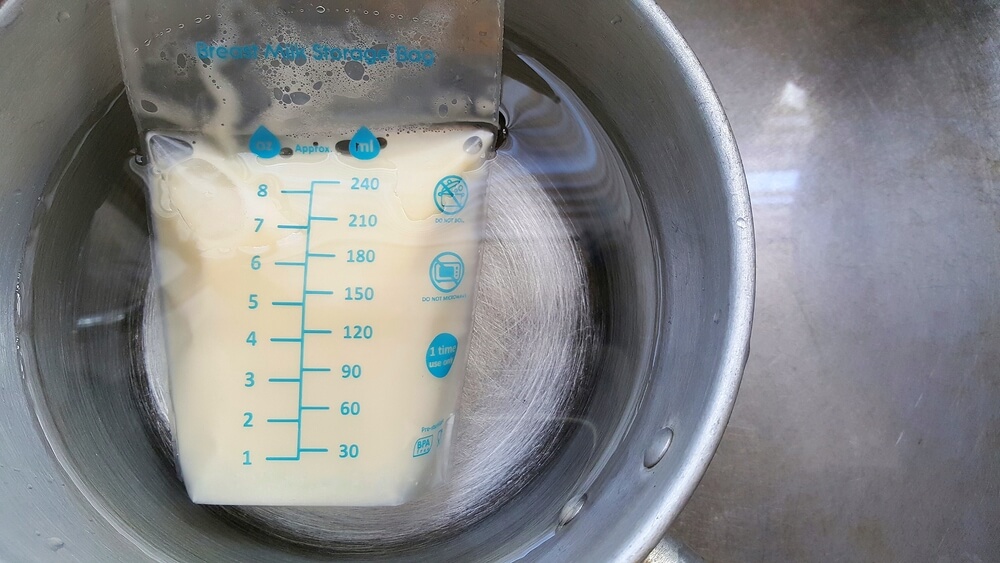Breast milk is considered the best source of nutrition for a baby during the first six months of life. As a new mother, you likely have many questions about breastfeeding and your baby’s feeding process.
One aspect of breastfeeding that might surprise and raise questions is breast milk color and how it changes.
Breast milk can display a vast array of colors, often reflecting what you consume in your diet, as well as the properties of the milk that benefit your baby’s growth and development.
It’s important to understand that color changes are typically normal and are often an indication of your body’s amazing ability to adapt and provide your baby with the necessary nutrients.
Key Takeaways
- Breast milk’s color may vary due to dietary factors, transitioning stages of lactation, and your baby’s specific needs
- Unusual color changes may warrant consultation with a healthcare professional but often have harmless explanations
- Proper storage and handling of breast milk can help mothers maintain optimal breast milk quality for their babies
Breast Milk: An Overview

As a new mother, I’ve come to learn that breast milk is an incredible, ever-changing substance designed to provide the perfect nutrition for my baby. In the first few days after birth, I produce a thick, yellowish substance called colostrum.
Colostrum, also known as the “first milk,” is packed with essential nutrients, antibodies, and proteins that help protect my baby from infections and support their immune system.
After a few days, my breast milk starts to transition, becoming a mixture of colostrum and mature milk. This is referred to as transitional milk. Transitional milk contains higher levels of lactose, fat, and calories, which are essential for my baby’s growth and development.
As my milk production continues, the transitional milk slowly shifts to mature milk, which will make up the majority of my baby’s diet for their first six months.
Mature breast milk is more abundant and has a thinner consistency than colostrum. It consists of two types: the foremilk and the hindmilk. The foremilk is the initial milk produced at the start of nursing, and it is watery and rich in proteins.
Hindmilk, on the other hand, comes later in the feeding and is thicker, containing higher levels of fat necessary for my baby’s energy and healthy growth.
Breast milk color may vary depending on various factors, such as the stage of milk production (colostrum, transitional, or mature milk) and my diet. It can range from yellowish to bluish-white or even have a greenish tint.
While the color may change, I am confident that my body will continue to produce the ideal milk for my baby’s needs.
Breast Milk Color and How It Changes
As a lactating mother, I have observed that breast milk can exhibit a range of colors. When I first started lactating, I was surprised to see the different hues my breast milk took on over time.
In the initial days after giving birth, my breast milk had a yellowish tint. This is called colostrum, and it’s a nutrient-rich milk packed with antibodies and immunoglobulins to help boost my baby’s immune system. As the days passed and my milk supply increased, the color gradually transitioned to a more white or sometimes clear appearance.
This is the mature breast milk, containing all the vital nutrients my baby needs to thrive.
At times, I’ve noticed greenish or bluish tones in my breast milk. The cause for this could vary. Some possible causes include a diet rich in green vegetables or a mild imbalance in foremilk and hindmilk, which is natural and not a cause for concern.
Another common reason for a slightly blueish tint to my breast milk is due to its high water content, catering to my baby’s hydration needs.
Occasionally, I’ve observed my breast milk taking on a pinkish or even red hue. This can be a result of a small amount of blood in the milk, mostly due to cracked nipples or a harmless condition called rusty pipe syndrome, which resolves on its own.
When I eat certain foods or take some medications, I might see shades of tan, brown, or orange in my breast milk. This is generally a benign change in its color, attributed to my diet or medication intake. In any case, if my breast milk turns black, it would be advisable to consult a healthcare professional, as it can indicate an issue with the breast.
In conclusion, as a breastfeeding mother, it’s essential to be aware of the color spectrum of breast milk and understand that slight variations in color are usually normal. However, if I ever have concerns or doubts about the color or consistency of my breast milk, reaching out to a healthcare professional for guidance is the best course of action.
Causes of Color Changes in Breast Milk

Diet and Nutrition
Sometimes the color of my breast milk can be affected by the foods and beverages I consume. For instance, eating vegetables such as spinach, seaweed, kale, and other green foods may result in green breast milk. Similarly, drinking beverages like orange soda or ingesting artificial food dyes can also alter the color of my breast milk.
Some examples of foods that may cause color changes include:
- Beets, which can make my breast milk appear pinkish or reddish
- Green vegetables and herbs like spinach and kale, possibly resulting in blue, green, or even black breast milk
It’s important to note that these color changes are typically harmless and do not affect the quality or nutritional value of the breast milk.
Medications
Certain medications can also cause changes in the color of my breast milk.
For example, Minocycline (also known as Minocin) is an antibiotic that is known to cause blue or greenish discoloration. Additionally, some vitamins and supplements, such as iron supplements and multivitamins, may also affect the color of my breast milk.
If I notice any unusual changes in breast milk color after starting a new medication, it’s a good idea to consult with my healthcare provider to ensure the medication is safe for breastfeeding.
Health Conditions
There are also health conditions that may lead to changes in breast milk color.
For example, breast infections such as mastitis can cause my breast milk to turn a yellow or even green hue. If I suspect a breast infection, it’s crucial to seek medical attention promptly, as untreated infections may lead to complications. Another reason for color changes could be cracked nipples or a rupture, which might introduce blood into the milk and cause a pink or brownish tone.
Lastly, although rare, certain forms of breast cancer may also alter the appearance of breast milk. If I’m ever concerned about the color or consistency of my breast milk, reaching out to a healthcare professional for guidance is always the best course of action.
Transitional Changes in Breast Milk
During the breastfeeding journey, I’ve observed that the color of my breast milk changes. In the first few days after delivery, my milk was a thick, yellowish liquid called colostrum. Colostrum is rich in antibodies, white blood cells, and lactoferrin, which provide essential nutrients and immune protection for my newborn.
As the days went by, I noticed my breast milk gradually becoming lighter in color and thinner in consistency. This transition phase usually occurs between days 5 to 14 postpartum. My milk’s fat content and protein composition also started to change.
During this time, the milk contains a mix of both colostrum and the more mature milk my baby needs for growth and development.
In the transitional stage, I observed that my breast milk separates into two distinct types: foremilk and hindmilk. The foremilk, which is the first milk that comes out during feeding, is thinner and has a bluish tint. It is lower in fat and higher in lactose, which provides energy for the baby.
The hindmilk, which follows the foremilk, is creamier and higher in fat content. This helps in facilitating my baby’s growth and in satisfying their hunger.
Throughout the breastfeeding journey, the color and composition of my breast milk continue to evolve in response to my baby’s changing needs. As my baby grows, the concentration of protein decreases while the fat content and overall volume increase.
This ensures my baby receives the necessary nutrients for optimal growth and development.
Breast milk is a remarkable substance that naturally adjusts to a baby’s needs. By observing these transitional changes, I am reassured that my body is providing my baby with the best possible nutrition.
Potential Concerns and When to Seek Medical Advice

During my breastfeeding journey, I noticed that there are a few potential concerns related to the color of breast milk, which might require medical attention. It is essential for me to know when to consult a doctor or health care provider.
I am aware that rusty pipe syndrome is a condition in which breast milk might have a brownish or rusty color. This usually occurs in the early days of breastfeeding, resulting from increased blood flow to the breasts, and generally resolves on its own.
If this color persists, I should contact my healthcare provider.
Sometimes, I may notice traces of blood in my breast milk – it can be due to bleeding or cracked nipples. Although this is not harmful to the baby, I must consult a doctor to address the underlying cause and prevent further complications.
Apart from bleeding, an infection known as mastitis can cause pink or red-tinged milk. Mastitis is characterized by inflammation, redness, and pain in the breast. If I suspect mastitis, it is crucial to seek medical help immediately, as untreated mastitis might lead to severe health complications.
Lastly, if I observe any unusual changes in the appearance and color of my breast milk, such as green or blue hues, accompanied by other worrisome symptoms like breast lumps or persistent pain, I must not hesitate to consult my health care provider.
Although rare, it is vital to rule out any possibility of breast cancer and receive timely treatment.
It is essential for me to be vigilant about the changes in breast milk color and seek medical advice when necessary. Being informed and proactive about my health will not only ensure my well-being but also contribute to my baby’s overall health and development.
Breastfeeding and Hydration
As a breastfeeding mother, I understand the importance of staying properly hydrated. Drinking adequate amounts of water is crucial for maintaining optimal milk production. It’s essential for me to consume enough water and other fluids to replace those that are used to create breast milk and maintain overall well-being.
When looking for alternatives to water, it’s best for me to be mindful of my choices. Drinking soda comes with excess sugar and potential adverse effects on my health. I should opt for healthier options, like unsweetened herbal teas, which can provide hydration without the extra calories.
Sports drinks, like Gatorade, can be helpful in some cases. For example, after exercising, I may prefer to consume a sports drink to replenish lost electrolytes and provide additional hydration.
Nevertheless, it’s important to recognize that sports drinks can also contain high sugar content and may not be necessary for everyday hydration.
Maintaining proper hydration is vital for both my health and my baby’s. While water is the best choice, I can occasionally consider other drinks like herbal teas and sports drinks, provided I keep an eye on the sugar content.
Staying mindful of my fluid intake will ensure I produce enough milk and sustain good overall health.
Storing and Handling Breast Milk

I understand the importance of properly storing and handling breast milk, as it can impact the quality and safety of the milk my baby consumes.
To ensure my baby receives the best nutrition, I follow these guidelines for storing and handling breast milk:
- Volume: I store my breast milk in small quantities, typically between 2-4 ounces per container. This helps avoid wasting milk and ensures that only the amount needed is thawed or warmed up.
- Temperature: I store fresh breast milk in the refrigerator at a temperature of 32-39°F (0-4°C) for up to four days. For longer periods, I opt for freezing the milk at a temperature of 0°F (-18°C) or below. It can be safely stored in the freezer for up to 12 months, but I prefer to use it within six months for optimal quality.
- Cooling: When expressing breast milk away from home, I make sure to cool the milk as soon as possible. I use insulated bags with ice packs or a portable cooler to maintain the appropriate temperature until I’m able to transfer it to a fridge or freezer.
- Freezing: For freezing breast milk, I use airtight containers or breast milk storage bags, which I label with the date of expression. I leave a bit of space at the top to allow for expansion during freezing.
- Thawing: When it’s time to thaw frozen breast milk, I place the container in the refrigerator. This can take up to 12 hours, so I plan ahead. In case of emergencies, I use a bowl of warm water or run it under warm tap water. I avoid using a microwave to thaw or heat the milk, as it can create hot spots that may burn my baby or degrade the milk’s nutritional quality.
- Delivery: When preparing breast milk for feeding, I gently swirl the container to mix the fat that may have separated. I avoid shaking the milk, as it can create bubbles that could cause gas in my baby.
By following these guidelines, I can be confident in knowing that my baby is receiving the best possible nutrition from my breast milk.
Breastfeeding and Baby’s Health
Breast milk is a complete source of nutrition for babies. It provides essential nutrients, including proteins, fats, vitamins, and minerals necessary for a baby’s growth and development. As a mother, I ensure that my baby gets the appropriate amount of breast milk for optimal growth and health.
One significant benefit of breastfeeding is that it aids in the development of a baby’s immune system. Breast milk is rich in antibodies and immune-boosting substances that help protect the infant against various infections and diseases.
The American Academy of Pediatrics recommends exclusive breastfeeding for the first six months of life, followed by continued breastfeeding alongside complementary foods up to one year of age or as long as mutually desired by mother and baby.
This ensures that the infant receives the full range of immune protection and other health benefits.
Additionally, breastfeeding promotes a healthy digestive system in babies. Breast milk is easier to digest than formula, often resulting in less gas and fewer digestive issues. Suckling at the breast also helps further develop a baby’s oral muscles, which can aid in speech and feeding development.
It is essential to recognize that breast milk’s color and appearance may change over time, reflecting the changing nutritional needs of the growing baby. This is entirely normal and does not indicate a problem with the quality or safety of the milk.
The composition of breast milk adjusts to meet the infant’s requirements, ensuring they receive optimal nutrition at every stage of their development.
Breastfeeding plays a crucial role in enhancing a baby’s health by providing all the essential nutrients and supporting the development of the immune and digestive systems. I am committed to ensuring that my baby receives the best start in life through the incredible benefits of breast milk.
Understanding the Normal Variations of Breast Milk

Breast milk is often referred to as “liquid gold” for its immense benefits for a baby’s growth and development. However, many new mothers may be concerned by changes in their breast milk’s color and consistency. I want to assure you that these changes are often normal and depend on various factors.
In the first few days after giving birth, the breast milk produced is called colostrum. It is a thick, yellowish liquid rich in antibodies and essential nutrients that help protect a newborn’s immune system. As my body starts to produce more milk and my baby grows, the composition of my breast milk will change.
Usually, after a few weeks, my breast milk will transition into a thinner, more opaque, and white color. This is known as mature milk, and it contains the right balance of fat, carbohydrates, protein, and other vital nutrients for my baby’s ongoing development.
In some cases, my breast milk may take on a slightly bluish or greenish hue. This can happen when there’s a higher concentration of the protein called foremilk, which is the initial watery milk produced when I begin nursing.
The subsequent milk produced, called hindmilk, is creamier, thicker, and higher in fat content.
Occasionally, my breast milk might turn pink, orange, or brown. It could be because of something I have consumed, such as certain foods or medications, which can cause temporary changes in its color. If I notice this, I can try to track the foods I eat and consult a healthcare professional or lactation consultant for guidance.
Regardless, these changes in color are typically harmless and do not affect the quality of my breast milk.
In conclusion, it’s essential to remember that variations in breast milk color and consistency are normal and expected. As a lactating mother, I can be confident that my body is producing the optimal nourishment for my baby.
If I have concerns about the quality or appearance of my breast milk, I can seek guidance from a healthcare professional or lactation consultant.
Conclusion
In my experience, understanding the color changes in breast milk can be quite fascinating. As a new mother, I have noticed various shades, from yellowish to bluish colored, indicating that the composition of breast milk alters depending on my baby’s needs.
This natural process ensures that my baby gets the proper nourishment at different stages of development during breastfeeding.
While breastfeeding, I have observed that colostrum, the first milk produced, is typically a yellowish color. This milk is rich in antibodies and nutrients, providing my newborn with essential protection and nourishment.
As the baby grows, the color of breast milk gradually changes to a more translucent or bluish hue, indicating a higher water content to keep the baby properly hydrated.
Feeding patterns also play a considerable role in breast milk color changes. For instance, when I feed my baby frequently, the fat content of the milk may increase, leading to a creamier appearance.
Knowing these color variations has given me the confidence that I am providing my baby with optimal nutrition tailored to their needs.
In conclusion, I find it comforting to know breast milk’s unique ability to adapt its nutrient levels and composition to meet my baby’s developmental needs. By being aware of these color changes, I can monitor the quality of my breast milk and ensure that my baby is getting the best possible nourishment during our breastfeeding journey.
Frequently Asked Questions
What causes changes in breast milk color?
Breast milk color can be influenced by a variety of factors, such as the mother’s diet, stage of lactation, and overall health. Foods with strong pigments, like beets and leafy greens, can cause subtle changes in the milk’s hue.
Hydration levels and medication can also affect the color of breast milk. It is important to note that these changes are generally normal and not a cause for concern.
How does breast milk color change during different stages of lactation?
During the first few days after giving birth, I produce colostrum — a thick, yellowish substance rich in nutrients and antibodies. As my body transitions to producing more mature milk, the color gradually changes to a thinner, bluish-white or cream hue.
This shift in appearance reflects the changing composition and nutritional content of my breast milk, which is customized to meet the evolving needs of my infant.
How can illness affect the color of breast milk?
If I am fighting an infection or feeling under the weather, my immune system produces more white blood cells, which can make the breast milk appear slightly yellow or green. This change is usually temporary and disappears once I recover.
It is still safe to breastfeed my baby during this time, as the antibodies in my milk can help protect them from illness.
What does breast milk color indicate about its nutritional content?
The color of my breast milk does not necessarily indicate its nutritional content. Although transitions in color can reflect changes in the composition of my milk, the milk remains rich in essential nutrients my baby needs to grow and develop.
It is important not to judge the quality of my breast milk based on appearance, as variations in color can be influenced by many factors unrelated to nutritive value.
Can the color of stored breast milk change over time?
Yes, the color of my stored breast milk may change over time. When refrigerated, the fat content may separate from the liquid component, giving the milk a bluish hue. If I freeze my breast milk, it might take on a yellowish tint due to the formation of crystals.
These changes do not adversely affect the nutritional value, and once the milk is gently swirled or warmed, the color and consistency become uniform again.
How is the color of breast milk affected by mastitis?
Mastitis is an inflammation of the breast tissue, often caused by an infection. When I have mastitis, my breast milk might appear pink or tinged with blood due to the inflammation. Although this can be alarming, it is usually safe to continue breastfeeding my baby.
It is important to consult with a healthcare provider to ensure proper treatment and management of mastitis.














